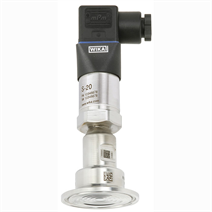In the field of pressure sensors, a distinction must be made between temperature range and limit.

First, we define temperature as a physical quantity that measures the level of thermal agitation of a body or system. In many cases, it can vary within a more or less wide range, depending on the environmental conditions or circumstances in which it is located. In this case, we talk about the range.
In the case of the limit, instead, we mean the minimum or maximum temperature that a system or a body can withstand without suffering damage.
Let’s see them in detail.
The temperature range and temperature limit in comparison
The range is the span that a system or substance may experience in a given period of time or situation. For example, the temperature range of a room can vary from 10 ºC to 30 ºC during a day, depending on external environmental conditions and the use made of the room.
The temperature range is an important concept in many fields of science and technology, since it determines the operating conditions of many systems and equipment. For example, the range of a refrigerator must be between 0 and 4 ºC to ensure that the food stored inside remains fresh.
In addition, there is also the concept of temperature limit which, as we said, indicates the maximum or minimum that a system or a substance can withstand without suffering damage or irreversible changes. For example, the limit of a material can be the maximum at which the material can be exposed without deforming or breaking, or it can be the minimum temperature below which the material will shatter or break.
Limit is an important concept in many fields of engineering and production, as it allows to establish the limits of use of a material or component in relation to the conditions to which it will be subjected.
Both concepts are fundamental to understanding the behavior of systems and materials in relation to temperature, and to predict and prevent any damage or malfunction.
Ultimately, the two concepts express the same thing in relation to temperatures: the range and the limit are defined by a lower and higher value, for example 0-C-100 C. However, IEC 61987 defines a difference.
IEC 61987 speaks about two different specifications
The standard we refer to is IEC 61987, which deals, among other things, with the properties of sensors for use with fluids, which also include pressure sensors.
With “range” and “limit”, the norm indicates two different specification characteristics. As a result, the range describes the span in which the instrument specifications are to be applied, primarily accuracy. The limit, on the other hand, indicates the minimum/maximum values between which the instrument can operate without being damaged. In this case, the instrument specifications should not be respected.
What may seem a bit boring makes perfect sense from a technical point of view. This can be illustrated by the example of a pressure sensor: the instrument must provide accurate measurement values in an ambient temperature range of 0 ºC to 100 ºC.
At the same time, the sensor must not suffer any damage at ambient temperatures between -20 % C and 0 &C. In this range, however, it does not need to provide accurate measurement results, or even measure them.
This seems paradoxical at first, but is plausible at a more careful analysis. The elements of the pressure sensor, that is, the actual measuring components, have a relatively large and often non-linear error. Without further precautions, reliable pressure measurement would be impossible. Therefore, the manufacturer must compensate for the temperature to reduce the error to an acceptable level. From an economic point of view, the limitation to a selected range makes sense or is even absolutely necessary.
The distinction between temperature range and limit applies to both the ambient temperature and the fluid one. It is also used for other specification features, such as overpressure.
For more information on pressure sensors, visit the WIKA website.


